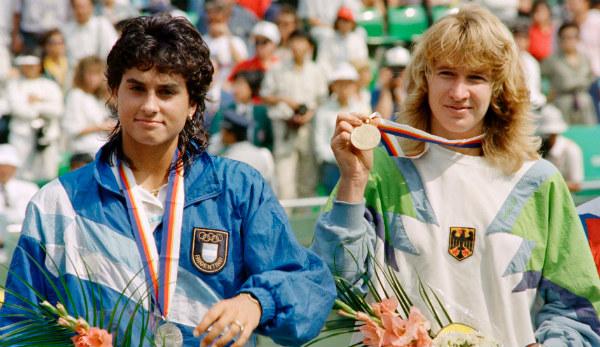Melbourne, Paris, Wimbledon, New York, Seoul: Steffi Graf’s Golden Slam celebrates its 30th anniversary on Monday.
When Steffi Graf was asked in the spring of this year how often she still plays tennis, she first had to smile. Graf always gets to hear this question when she denies one of her rare public appearances. Many believe that Graf is still regularly on the court, also because she still looks as fit and wiry as she did in her prime.
But tennis doesn’t really play a major role in her life anymore, and so she answered the question refreshingly honestly: “It’s become very rare. I think I’ve played enough tennis in my life,” Graf said, “when I play, it’s mostly for my husband’s foundation, for the Andre Agassi Foundation.”
Thirty years ago, however, everything was quite different. Steffi Graf was 19 years old, she played a lot of tennis, she was very successful, she stood for a new era in women’s tennis, she was the new number 1, and on 1 October 1988 she did something in Seoul in South Korea that nobody had ever done before. And what nobody managed to do afterwards: She won the so-called Golden Slam, i.e. all four major tournaments of the season and also the Olympic gold medal.
“Seoul, the final victory against Gabriela Sabatini, that was an extraordinary, important moment for me”, says Graf, “the gold medal at the Olympic Games stood out once again this year. The atmosphere at the games was very special, the communal experience with the other athletes. They’re great memories.”
Graf found her fulfillment today in a secluded life in Las Vegas, her husband’s hometown. Nothing pushes her into the public eye anymore, only very rarely does the 22-time Grand Slam winner complete a PR appointment for one of her many sponsors. Not a trace of scandals, affairs and excitement.
Graf is happy “not to read his name in the newspaper every day anymore.” Those who knew her better knew that she wanted exactly this life after tennis, a life without flashlights and attention. Boris Becker, her long-time companion, once said disarmingly: “She chose a completely different path than I did. I couldn’t do that.” And who could doubt that?
In 1988, however, around the count’s appearance in Seoul, the hype around the young superstar Graf was big. He could hardly have been bigger. Graf was one of the faces of these games, she was also THE face of the sport tennis returned to Olympia. Graf came to Seoul as a new US Open winner, she had already managed the rare feat of winning all four Grand Slams in one calendar year. “I was pretty tired, pretty exhausted. I didn’t really have much hope for this Olympic competition”, Graf says in retrospect, “I definitely wanted to enjoy the experience of the Games myself”.
The world’s best tennis player first moved into a room in the athletes’ village together with her German colleagues like Claudia Kohde-Kilsch or Sylvia Hanika. But soon the stay became a nerve test, a stress test. Wherever the 19-year-old walked along, there were immediately fancies from other athletes. “Everyone wanted to be photographed with her, everyone wanted an autograph,” recalls Klaus Hofsäss, long-time Fed Cup coach, “it was madness! Then father Peter Graf pulled the ripcord and ordered his daughter into a hotel room to “save the mission gold”, as he later said.
The Gold Mission. She was only in danger once, in the quarter-finals, when Graf was 1:3 behind Russian Larissa Sawtschenko in the third set and there was a sensation in the air. But Graf took the risk, won the next five games in a row and was no longer at risk until the moment when she turned her first match point against Gabriela Sabatini in the final.
“It was one of the most beautiful moments of my career. The 1999 French Open victory was probably more emotional,” says Graf, “the last Grand Slam success of my career.
Many have tried since the October days of 1988 at the Grand Slam to win the four Grand Slam tournaments in a single season. Serena Williams was close in 2015, having already won Melbourne, Paris and Wimbledon before surprisingly failing in the semi-final in New York against Italian Roberta Vinci.
She too, the most successful player of this epoch, will probably fail in this challenge, especially in a repeat of the Count’s Golden Slam. Completed on October 1, 1988, it remains a moment for eternity. Maybe even a unique moment.














You must be logged in to post a comment Login